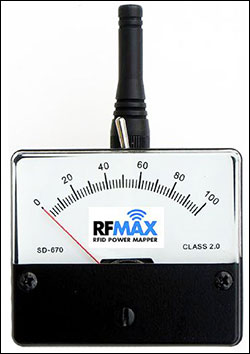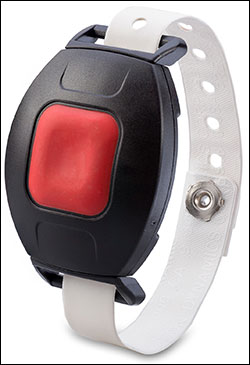Mar 26, 2015The following are news announcements made during the past week by the following organizations:
Arcadian, RFMAX;
HID Global;
CISC Semiconductor, MET Labs;
Elpas;
Cartamundi, Van Genechten Packaging, PragmatIC, Smartrac, TNO, imec; and
Tapcentive.
RFID Antenna Supplier Arcadian Launches RFMAX Product Line
Arcadian, a New Jersey-based distributor of commercial antennas and wireless equipment, has announced the launch of RFMAX, its new line of antennas, weatherproof enclosures, cables and related hardware for the RFID market. The company plans to officially launch RFMAX at this year's RFID Journal LIVE! conference and exhibition, to be held in San Diego, Calif., on Apr. 15-17.
The RFMAX product line, the company reports, encompasses a range of products designed to solve everyday RFID challenges and to simplify RFID systems setup. The initial lineup of RFMAX products includes RFID reader enclosures designed to protect sensitive RFID equipment from the elements and simplify system setup; RFID race-timing antenna kits that include everything needed to set up antennas for an RFID race-timing system; and RFID Power Mapper, a handheld passively powered meter for mapping RF signal patterns and strength, and for identifying null or dead spots. The RFMAX product line also includes RFID antennas designed to meet unique application requirements and outperform existing products in the RFID space, as well as RFID jumper cables designed for quick connections and peak RFID performance.
"Our focus is to bring to market unique and robust products to fill a variety of gaps in the existing RFID space, enhancing the ability of RFID VARs and system integrators to offer the best possible solutions for the end user," said Michael Crudele, Arcadian's president, in a prepared statement. "We're creating these products based on Arcadian's many years of experience in RFID antenna applications."
HID Global Announces Commercial Availability of HID Trusted Tag Services
HID Global has announced the commercial availability of HID Trusted Tag Services, a cloud-based authentication platform designed to provide a comprehensive and easy-to-use secure authentication environment that, according to the company, adds trust to "proof-of-presence" and Internet of Things (IoT) applications using Near Field Communication (NFC) technology. The commercial launch makes the services available for purchase by systems integrators, business application providers, Web application providers and other solution providers seeking to incorporate "proof-of-presence" capabilities into their programs, services and offerings.
The HID Trusted Tag Services include back-end software and servers, and work with HID Global's Trusted Tag, first unveiled in 2013 (see HID Global Offers Security for NFC and HID Trusted Tag Offers Secure NFC Connection Without App). The back-end systems authenticate each tag read before sharing data with an individual's smartphone or other NFC reading device. Only HID Global's Trusted Tag, with HID's own chip and firmware, can operate with the Trusted Tag Services, the company explains. The tag's internal software employs HID's Seos technology, which has the ability to generate a one-time password amounting to a specific version of a URL that will not be used more than once for that tag. That URL must then be verified during each read event, by the Trusted Tag Services software running on HID Global's cloud-based server, before it can transmit data to an NFC reading device.
According to HID Global, the service optimizes security and prevents cloning by authenticating each tap of a tag via an automatically changing URL, while eliminating the inconvenience of other cryptographic solutions that require the installation of dedicated apps for each use case. The solution can also be used to validate the authenticity of documents, goods and additional items for brand protection and other purposes. HID Trusted Tags feature 8 kilobytes of storage capacity to support practically any use case, the firm reports, and the tags are available in different shapes, sizes and materials: secure contactless ISO cards, epoxy key fobs and self-adhesive inlays that turn any location into a hot spot for NFC-enabled smartphones or readers. HID Global also offers the option of designing custom tag form factors for special customer needs, and HID Trusted Tag technology can be embedded into virtually any RFID tag form factor.
The company has already tested HID Trusted Tag Services a number of times. For example, in November 2014, HID Global announced the results of an ongoing pilot deployment designed to test its HID Trusted Tag Services and NFC high-frequency (HF) passive RFID tags, known as the HID Trusted Tags, which are tamper-proof and feature unique security and privacy attributes (see HID Global's NFC Tag Pilot Demonstrates 'Proof Of Presence' For Home Care). The pilot, conducted with Integrity Home Care, was designed to test HID Trusted Tag Services' ability to provide real-time authentication of caregiver visits via smartphones. According to HID Global, the pilot illustrates that NFC technology and HID Trusted Tag Services, in particular, are effective mechanisms for location authentication, which is the critical first step in maintaining compliant documentation of patient encounters.
HID Global plans to demonstrate its HID Trusted Tag Services for electronic visit verification and digital out-of-home campaigns in its booth (118) at this year's RFID Journal LIVE! conference and exhibition, being held in San Diego, Calif., on Apr. 15-17.
CISC Semiconductor, MET Labs Partner on GS1 EPC Gen2v2 Compliance Testing
CISC Semiconductor, an Austria-based provider of RFID test and measurement tools, and MET Laboratories, an independent testing authority and GS1-approved test house based in Baltimore, Md., have announced that they are collaborating to deliver a validated conformance test tool for GS1 EPC ultrahigh-frequency (UHF) Gen2v2 certification testing.
GS1's management board ratified the Gen2v2 standard in 2013 (see GS1 Ratifies EPC Gen2v2, Adds Security Features, More Memory) and, half a year later, began developing a conformance test specification for new products requiring certification. The GS1 EPC Gen2v2 conformance test specification, along with the interoperability test specification, are scheduled to be finished this month and ratified in June, according to CISC and MET. The testing is an extension of the current test standard, the companies report, with new features such as electronic article surveillance (EAS), tag alteration with crypto challenge, authentication and consumer electronics.
CISC will provide a test solution supported by both of its test platforms, RFID Xplorer (see CISC Intros Tests to Meet GS1 US Tagged Item Performance Protocol Guideline) and RFID MeETS (see CISC Launches RFID Tag Evaluation System). Both solutions are already available for tag-performance testing, air-interface analysis and conformance tests, and can be software-upgraded to become a fully automated Gen2v2 conformance tester with a graphical user interface (GUI) for detailed analysis.
MET Labs is the official testing provider for GS1's EPC RFID hardware and software certification programs, and, according to the two companies, has a special competency in RFID testing to assure safety, electromagnetic compatibility, and tag and reader interoperability. Working with the U.S. Food and Drug Administration and AIM Global, MET Labs also developed a program to determine potential adverse effects of RFID emissions on electronic medical devices. Additionally, MET provides testing services for various ISO and IEC high-frequency (HF) and UHF RFID standards.
Elpas Introduces Mother Bracelet for Infant-Protection System
Elpas, part of Tyco Security Products, has announced the expansion of its active RFID Infant Protection Solution with the introduction of the Elpas Mother Bracelet, an RFID-enabled wearable electronic wristband designed for ease of use by mothers and hospital personnel in maternity departments.
The Mother Bracelet is used to ensure the accuracy and safety of mother-baby pairings, and to prevent mismatches or possible infant abductions within maternity, obstetrics, neonatal and pediatric departments. The bracelet pairs with the RFID-enabled Elpas Charm. As part of the Infant Protection Solution, the Elpas Charm provides real-time indoor positioning data to determine an infant's location. A simple local match test may be performed at any time after initial pairing between Mother Bracelet and Infant Charm, indicating to the nursing staff or the mother that there is a proper match between mother and baby. Once paired with her infant, a mother may use the bracelet to escort her child through protected exits without triggering an alarm. The bracelet also has a wireless call button used to call for assistance as needed.
EU Companies Form PING to Develop Process for Printing NFC Electronics
Six companies—Cartamundi, Van Genechten Packaging, PragmatIC, Smartrac, TNO and imec—from four different European Union (EU) countries have launched PING, a consortium aimed at bringing flexible electronics from the lab to mainstream markets.
The name PING is derived from the consortium's mission to create a platform enabling the production of Printed Intelligent NFC Game cards and packaging. Flexible thin-film electronics and printed materials, such as cards, stickers and packaging, make a perfect combination for advancing the Internet of Things (IoT), according to the new consortium. PING is supported by Horizon 2020, an EU Research and Innovation program that has nearly €80 billion ($87.4 billion) of funding available over a span of 7 years (2014 to 2020) and is the financial instrument implementing the Innovation Union, a Europe 2020 flagship initiative aimed at securing Europe's global competitiveness.
PING intends to establish, within three years, a standardized low-cost and high-volume manufacturing process for embedding wireless identification and power-transfer technology into printed objects (for example, packaging, cards and stickers) and printable substrates (paper, cardboard and plastic, for instance). Such printed technology, based on innovative thin-film electronics, will enable the creation of objects that can be identified and interacted with via standard Near Field Communication (NFC) RFID reading devices (such as smartphones). Moreover, the consortium reports, the project will explore the integration of additional features, such as sensors, displays and sound, ultimately paving the way to the realization of the IoT and what it calls the Internet of Games.
Imec and TNO will focus on developing a flexible thin-film technology and chip design. PragmatIC will work with imec and TNO to align developed designs with its own mass-manufacturing processes, transferring future-generation NFC chips into commercial production. Smartrac will contribute its expertise in antenna design and printing technologies, with a special focus on the connection interface between the printed antenna and TFT electronics. Cartamundi and Van Genechten Packaging will perform the last step of the supply chain: embedding the electronics in printed products.
Tapcentive Releases SDKs for Platform Supporting Both NFC and Beacons
Tapcentive, an in-location marketing platform designed to unify mobile interactions with physical experiences to drive retail and brand engagements, has released full software development kits (SDKs) for iOS and Android. With these SDKs, marketers and app developers can add immersive, brandable in-location experiences to their own mobile apps.
Rather than forcing marketers to choose between the two most dominant mobile-engagement technologies on current smartphones—Near Field Communication (NFC) or Bluetooth Low-Energy (BLE)—Tapcentive's platform implements the best of each for iOS and Android, the company reports. The Tapcentive platform includes a cloud-based location- and incentive-management service, engagement hardware known as Touchpoints, and test apps for iOS and Android, available through the Apple and Google Play stores.
The Touchpoints, which incorporate both technologies (NFC RFID and Bluetooth beacons), are visibly branded icons that provide a clear and simple call-to-action for consumers. The icons are intended to be deployed prominently in-location, where consumers seek them out and choose to engage with a tap of their phone. Tapcentive's SDKs insulate the marketer and developer from differences in the technologies and underlying mobile operating system platforms, Tapcentive explains, making it easier for them to focus on developing and refining content that delivers the desired response from consumers.
Access to the platform starts by creating a free account through the Tapcentive website. Each account is provisioned with two virtual Touchpoints that enable marketers to use their existing iOS devices, beacons, NFC tags and Android devices to experience the full power of the Tapcentive platform, using the devices and technologies they already have available. Through Tapcentive Manager, marketers and developers can create and deploy their own incentives, choosing from a number of pre-built, gamified incentives or building from scratch. Tapcentive Manager also enables marketers to segment mobile audiences, manage limit settings and locations, and access reports that track all tap activities, offer and reward delivery, and redemptions.




